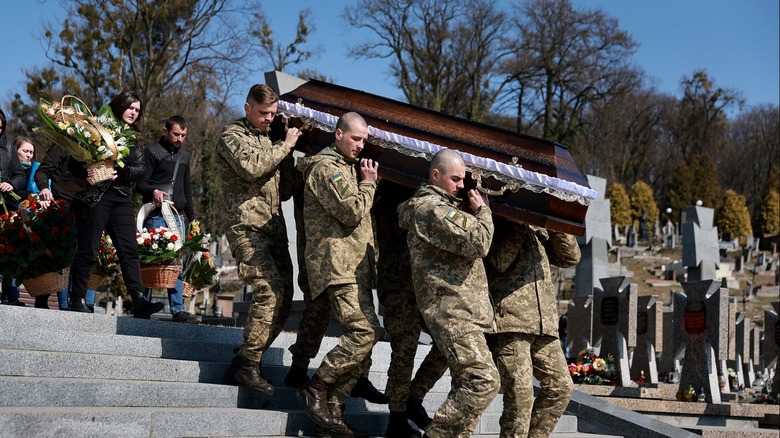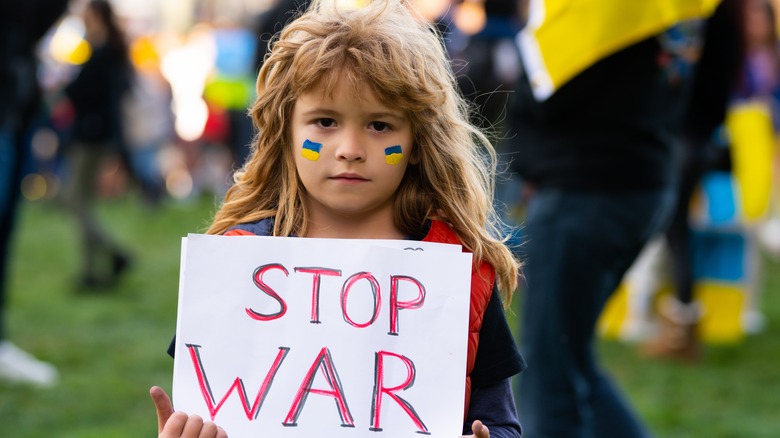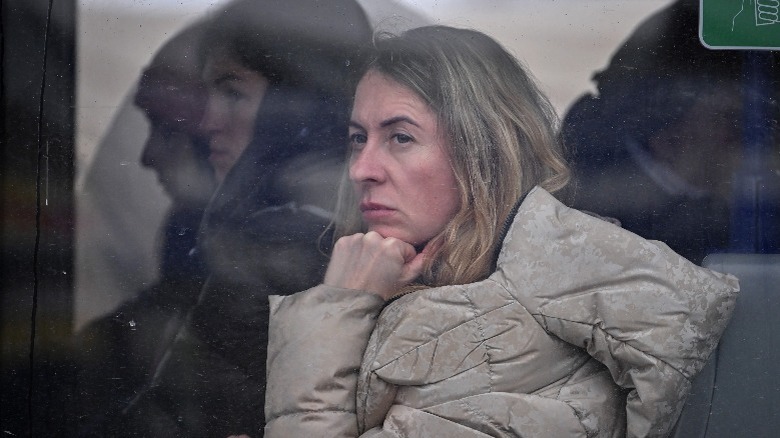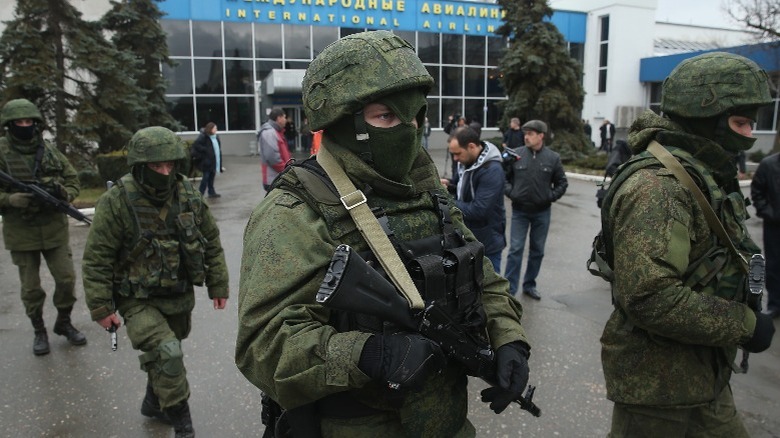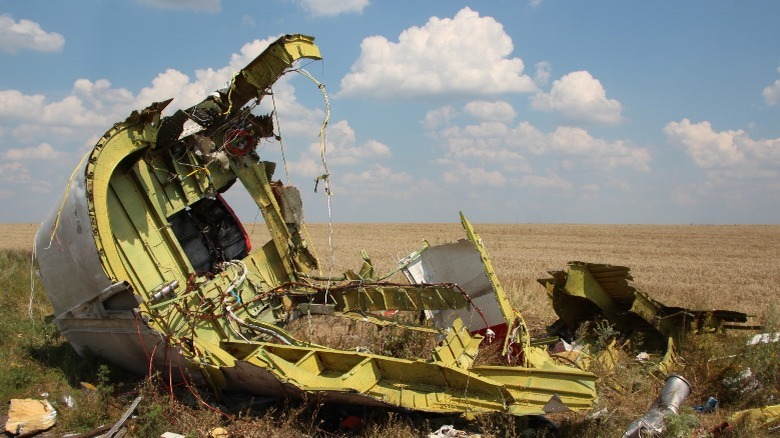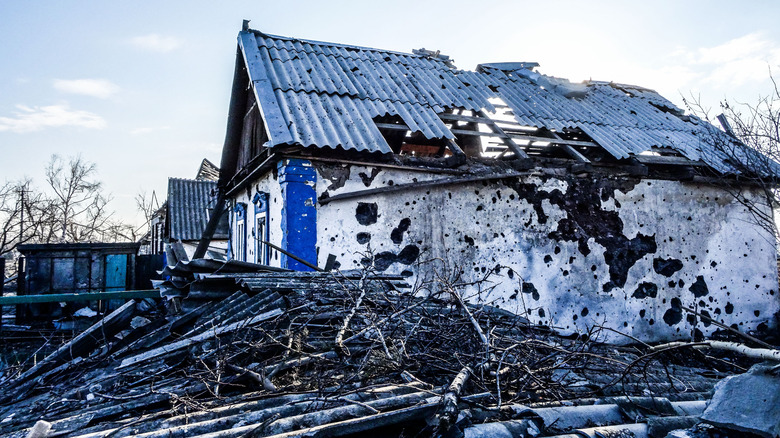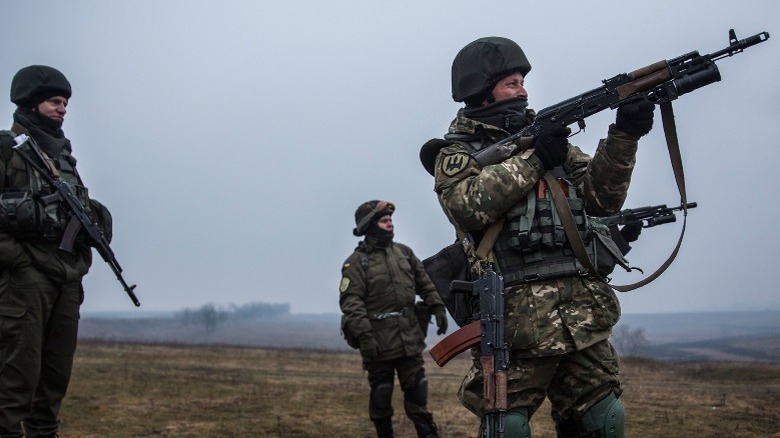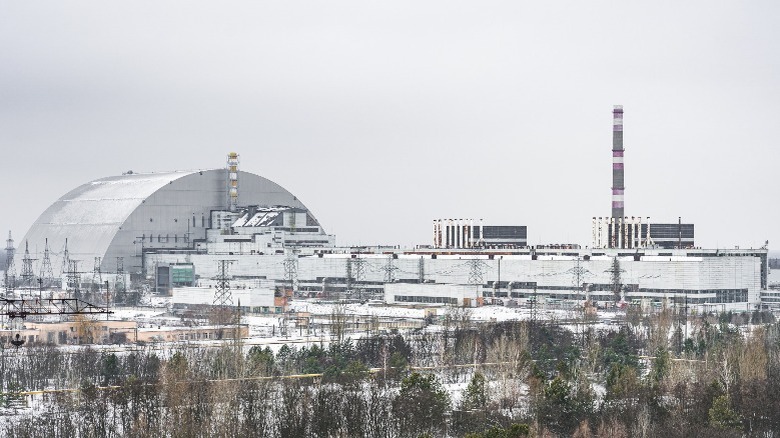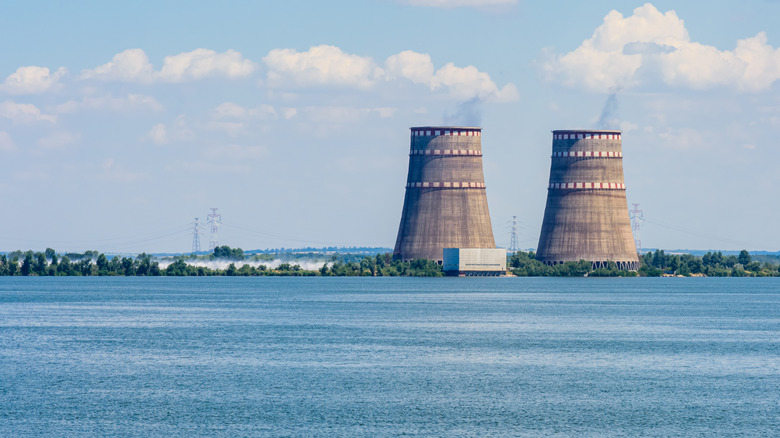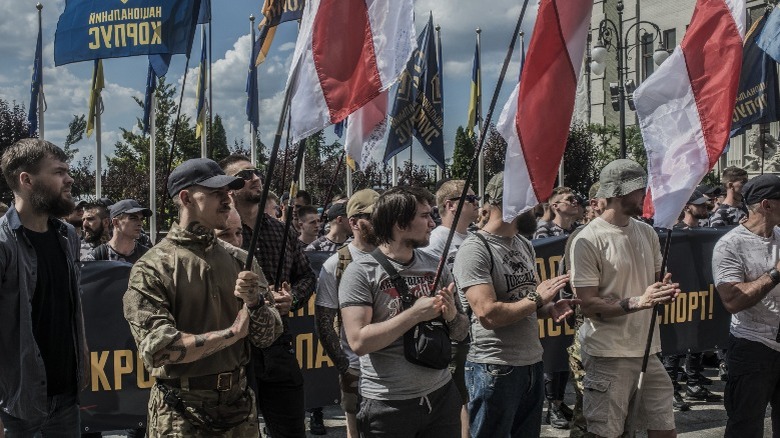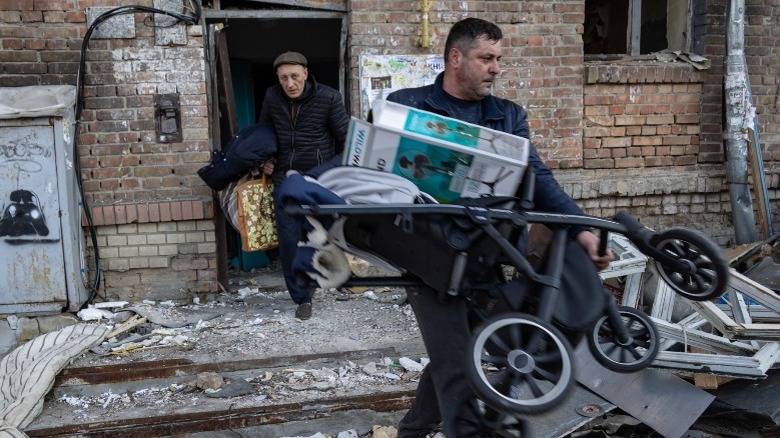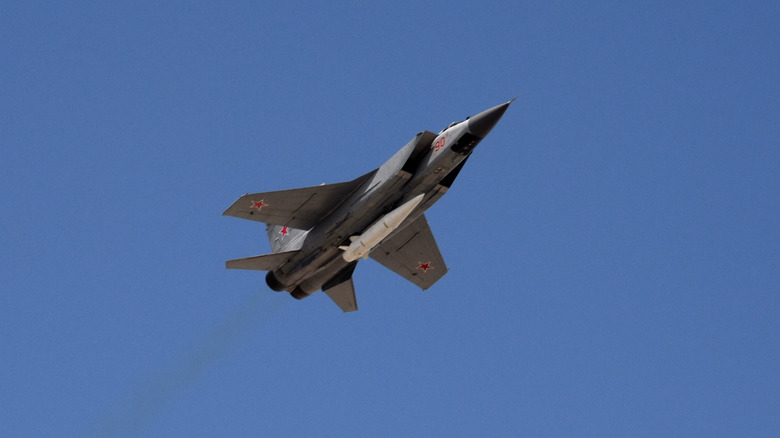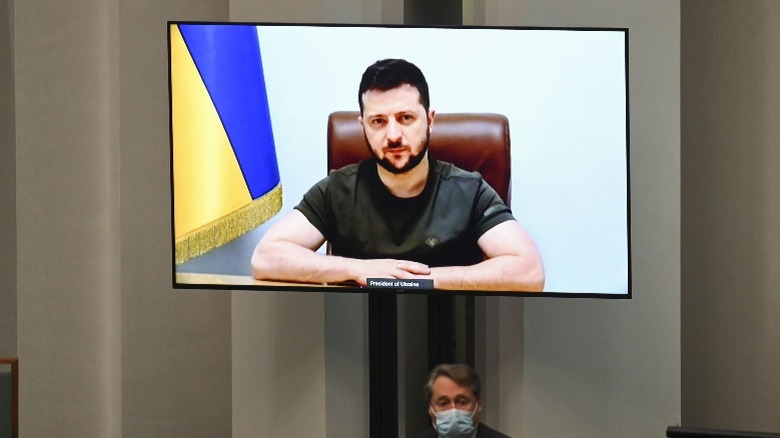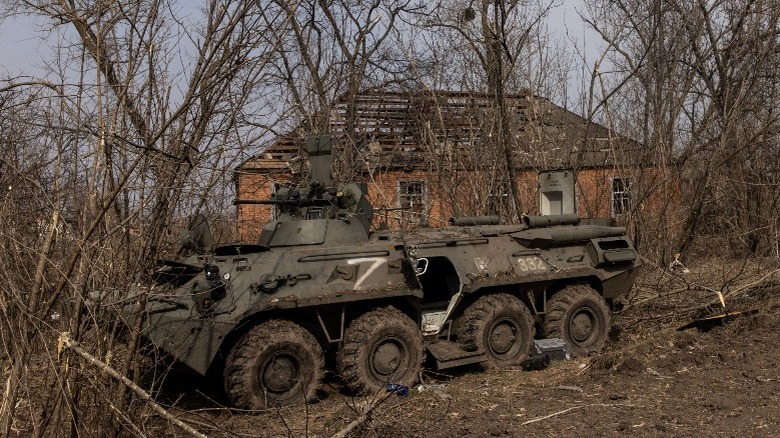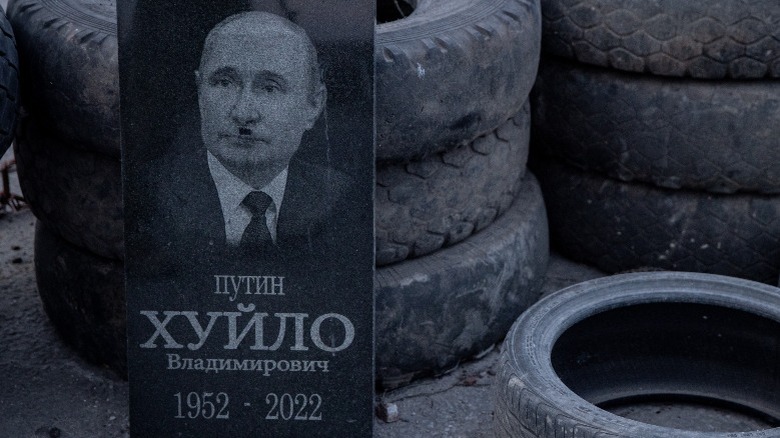Chilling Details About The Russo-Ukraine War
Recent headlines have been dominated by the Russo-Ukraine War since renewed fighting broke out in February 2022. The war initially started in 2014, when Russia invaded and annexed parts of southern and eastern Ukraine, according to Yahoo. Russia and Ukraine have a long and complicated history, with modern roots stretching back to the formation of the Soviet Union in the early 20th century. Ukraine was one of the 15 republics that made up the Soviet Union, and it did not become independent until 1991 (per Al Jazeera). Since then, the Ukrainian government has struggled to maintain democracy, and revolutions occurred in 2005 and 2014.
The 2014 Maidan Revolution ousted the Ukrainian president who was thought to be too pro-Russian. In the midst of the revolution, Russian troops appeared in the Crimea and the Donbas region in the south and southeast, and they forcibly annexed the Crimean peninsula (per the Brookings Institution). The Crimean Supreme Council then scheduled a referendum to decide if the area should accede to Russia. However, the referendum only provided two choices, and neither allowed for the status quo to remain. Since then there has sporadic fighting along the borders, until the 2022 Russian offensive broke the doors wide open again.
Wars have been responsible for some of the darkest and most tragic moments in human history, something eastern Europe is all too familiar with. The Russo-Ukraine War has unfortunately proven to be no different. These are chilling details about the Russo-Ukraine War.
Hundreds of children have been killed since 2014
In some of the most tragic news, many children have been reported as killed amidst the fighting and tumultuous humanitarian situation. In June 2020, the permanent representative of Ukraine to the United Nations, Sergiy Kyslytsya, revealed some of the gruesome figures. According to Kyslytsya (via the Permanent Mission of Ukraine to the U.N.), 147 kids had been killed since 2014, and increased shelling in the area, along with the raging coronavirus, was devastating them even further. A full quarter of children in the Donbas region were estimated to need psychological assistance, and 240,000 kids faced constant artillery fire and had to deal with landmines. He said more than 750 schools had been destroyed, and Russians were targeting school-age children for propaganda and hate speech.
According to the Independent, within three weeks of the 2022 invasion, 90 more kids had been killed in the renewed fighting. One of the victims, a 7-year-old girl, was killed by a cluster bomb. A 10-year-old girl named Polina with pink hair was reportedly shot to death in her car by Russian troops. In an Instagram post, the first lady of Ukraine, Olena Zelenska, decried the death and casualties and gave a sobering portrait of the harsh realities they faced. She noted many people needed urgent care or were sick and disabled, but they were stuck in shelters and basements. She pleaded for an end to the war, but boldly and bravely stated, "We will win."
There have been constant reports of sexual violence
Horrifying and shocking reports have emerged since the start of the invasion regarding sexual violence against both men and women. In 2018, Vice reported on an incident where Russian militants kidnapped a group of men and assaulted them, accusing them of being part of the Ukrainian Army and demanding tactical information about Ukrainian troops. The report also cited a local NGO in the Donbas region that stated that roughly one-third of women and a quarter of men had experienced or witnessed sexual assault by military officers.
In late March 2022, the New York Times published the account of a Ukrainian woman's devastating personal experience. She said Russian soldiers had murdered her husband before sexually assaulting her multiple times in the presence of her son. The Kremlin denied the story was true, calling it a lie. That same week, Ukrainian parliament member, Maria Mezentseva, claimed that cases had been severely underreported, and that soldiers were deliberately targeting senior citizens (per the Guardian).
If you or anyone you know has been a victim of sexual assault, help is available. Visit the Rape, Abuse & Incest National Network website or contact RAINN's National Helpline at 1-800-656-HOPE (4673).
The Russians tried at first to hide their involvement
During the 2014 Euromaidan protests, after the Ukrainians had ousted President Viktor Yanukovych, thousands of mysterious soldiers began showing up in the Crimean region (per the Atlantic). Reports identified the soldiers as belonging to the Russian military, but the Kremlin denied any official involvement. They instead suggested the soldiers were "local self defense forces" who had outfitted themselves from nearby army surplus stores. In advance of the upcoming referendum on Crimean independence from Ukraine, the Atlantic reported the green uniformed men had started setting roadblocks and surrounding army facilities.
However, Radio Free Europe/Radio Liberty (RFE/RL) captured an interview with one of the soldiers, who plainly admitted he was part of the Russian military. The state run Russian news agency TASS called the accusations false, and it was not until after the March 16 referendum passed and the Crimea joined Russia that the Kremlin started to change their tune. Russian government spokesman Dmitry Peskov admitted that some Russian forces were in the Crimea, but he refused to give specifics (per RFE/RL). Finally, a year after the invasion, in a state-produced documentary, Vladimir Putin openly admitted to sending in Russian troops to the Crimea. Putin claimed in the film he had no other option, and he said he had deployed "special forces ... marines and commandos there under the guise of reinforcing security for our military facilities in Crimea."
Civilians were killed when their airplane was shot down early in the war
One of the most calamitous events of the war occurred in July 2014, when a passenger airliner was shot down while making its way into Ukraine from the Netherlands. According to the Dutch Safety Board's 2015 official report, Malaysian Airlines flight MH17 was cruising at 33,000 feet when it was struck by a Russian-designed warhead. The missile instantly killed the three crew members in the cockpit on impact, and then the plane disintegrated, killing the other 295 people onboard. The report partly blamed the flight for even taking place at all during the conflict, suggesting those responsible for allowing the flight "did not adequately recognize the risks of the armed conflict in the eastern part of Ukraine over flying civil aviation."
The report itself did not take a position on where or who the missile was launched by, but in 2018, CNN reported that the Dutch investigators laid responsibility on the Russian 53rd anti-aircraft missile brigade. Yet, refuting the allegations covered by CNN, Russian news agency TASS said the Russian military bore no responsibility for the incident. The report claimed the Dutch investigators ignored evidence and stated the Russian government had evidence showing the missiles were really fired from a Ukrainian weapons system.
Within the first year both sides had been accused of war crimes
Within seven months of the invasion, reports started to emerge about possible war crimes. Amnesty International (AI) reported in September 2014 that both Ukrainian and Russian forces had committed multiple war crimes. AI also accused the Russian military of fueling the separatist forces' crimes by beefing up their military near the border, despite the ceasefire in place. The report cited satellite imagery for some of their conclusions and accused the Kremlin of lying about their responsibility in the conflict. AI's report also included many harrowing details about the abuses from the military forces. In one incident, separatist forces tortured and murdered one witness' neighbors. In another, they kidnapped five people in a church and demanded $50,000 in ransom money.
In October, AI reported that both pro-Ukrainian and pro-Russian forces had committed numerous summary, extrajudicial executions. Pro-Ukrainian forces were likely responsible for four murders in a Donetsk village, and separatist forces were also responsible for four murders in a nearby area, including a member of Ukrainian parliament.
Ukrainian volunteer battalions stopped humanitarian aid
In the weeks running up to the first Christmas of the war, in December 2014, Amnesty International (AI) reported that pro-Ukrainian volunteer forces were halting the flow of food and other humanitarian supplies to the separatist Donbas region. Denis Krivosheev, the director of Europe and Central Asia for Amnesty International, said that battalions and a militia had become "renegade gangs" terrorizing the area. The battalions prohibited trucks and convoys from bringing food and medicine into the Donbas, because they suggested it was not going to the civilians but instead to the soldiers they were fighting.
Soldiers started stopping and searching any cars that traveled through the border area, and the report noted the battalion had previously been accused of carrying out torture against their enemies. One humanitarian worker relayed a story that involved authorities seizing heart and blood pressure medication from elderly citizens. The report noted that 4,700 people had died in that region alone, and that by that point over half the area's population was reliant on the blocked food aid.
Russian soldiers forced Chernobyl technicians to operate at gunpoint
In an event that rekindled fears from 1986, in February 2022, Russian troops captured the decommissioned but still radioactive Chernobyl nuclear power plant. According to Radio Free Europe/Radio Liberty, Russian forces took over all of the Chernobyl buildings and storage facilities after a ferocious attack. Nobody was killed during the fighting, but it worried many in the international community about the potential for a nuclear disaster. Stoking even more fears, within weeks, NPR reported that Chernobyl had lost power and gone offline. They noted that the backup system only had two days of power, and that repairing the existing damages was impossible because of the risk due to the fighting.
In a distressing article, E&E News stated that Russian troops had forced the Chernobyl technicians to keep working and refused to allow them to leave. The workers complained of numerous medical issues relating to being overworked. There were over 200 workers held hostage by the Russians, and the only outside communication allowed were quick phone calls to their family.
Russian forces fired a missile at the largest active nuclear power plant in Europe
On March 4, 2022, in an attack that once again raised global fears about a nuclear disaster, Russian forces shelled the Zaporizhzhia nuclear power plant in Ukraine, the largest active nuclear power plant in Europe. According to the Associated Press, one of the shells started a fire, but it was quickly extinguished. One Ukrainian state official worried that the fighting could potentially disrupt the power supply to the plant, leading to a situation reminiscent of the 2011 Fukushima nuclear meltdown. Ukrainian President Volodymyr Zelensky cryptically stated, "If there is an explosion, that's the end for everyone. The end for Europe. The evacuation of Europe." A former Obama Administration official noted the Zaporizhzhia plant had numerous and extensive safety barriers put in place but still worried about potential complications.
According to NPR, the company responsible for managing the power plant was hit by a cyberattack at the same time as the attacks and announced there had been multiple casualties at the plant. The plant alone provides 25% of all of Ukraine's electricity. Even China, a Russian ally, put out a statement expressing concern over the situation. The Associated Press also reported that several countries in northern Europe saw increased demand for iodine tablets, which are known for reducing some of the potential effects of radiation poisoning.
A Ukrainian army battalion has neo-Nazi links
In a troubling development that raised many eyebrows, CNN reported early during the 2022 Russian offensive that a battalion in the Ukrainian army had serious neo-Nazi links. The Azov Battalion is a former autonomous militia that joined the Ukrainian National Guard in 2016. The group is the paramilitary wing of the Azov movement, a far-right movement associated with neo-Nazism and white supremacist ideology. For a time, United States Congress briefly considered labeling the Azov Battalion a foreign terrorist organization, but the Ukrainian government called these accusations false and defamatory.
According to a report from the United Nations, members of the Azov Battalion sexually assaulted and tortured a mentally disabled man in 2014. The same report noted in 2015, three members of the battalion had also tortured a suspected separatist for over a week before turning him over to their superiors. The Center for International Security and Cooperation at Stanford considers the group to be neo-Nazis that "champion white nationalist, anti-immigrant extreme-right ideas in Ukraine."
Russian forces shelled a hospital and killed a pregnant woman
In one of the saddest and most heart-wrenching moments of the 2022 Russian invasion, on March 14, the Associated Press reported on the death of a pregnant woman due to Russian shelling. The Russians had attacked a hospital in Mariupol, Ukraine, earlier that day, killing the woman and wounding two other pregnant patients. The report noted the Russians denied the details of the attack. They claimed the hospital had been taken over by Ukrainian forces, and that all patients had been evacuated. They also claimed at least one of the victims was an actor staging photos for propaganda use.
In late March, the World Health Organization (WHO) came out with a statement saying they had confirmed at least 64 separate attacks on hospitals in Ukraine since the 2022 invasion began (per Al Jazeera). They called the attacks shocking and unjustified. The WHO also said that roughly half of the country's pharmacies were out of commission, and that they had sent over 100 metric tons of medical equipment to Ukraine since the invasion started, but the country still needed much more.
Russian forces used hypersonic missiles and thermobaric bombs
In March, the Center for Arms Control and Non-Proliferation released a report stating Russian forces used thermobaric weapons, known as "vacuum bombs," in late February 2022. Thermobarics are not as devastating as nuclear weapons, and instead of a fission reaction, they rely on dispersing and igniting fuel to create a massive pressure and heat wave. According to Human Rights Watch (HRW), thermobaric weapons suck oxygen from the air, and the resulting wave ruptures internal organs and lungs, leading to death. HRW notes thermobarics were first used in the Vietnam War, and both the U.S. and Russia have used them in combat before.
In addition to thermobaric weapons, reports have also come out stating that the Russians have used hypersonic missiles, too. Per Reuters, the Russians admitted to using Kinzhal hypersonic missiles to target weapons depots throughout Ukraine. Hypersonic missiles are so devastating and dangerous, because they are hard, if not impossible, to detect with traditional radar (per Military.com). They use an advanced type of fuel and can outrun most weapons defense systems, including the U.S. aegis missile interceptor system.
The Russians may have tried to assassinate the Ukrainian President
Russian forces launched their 2022 offensive on February 24, and within a week reports had already come out that President Volodymyr Zelensky was the target of numerous assassination attempts. The Washington Post reported on March 2 that Ukrainian authorities had foiled a plan by Chechen special forces to take out the president. The Chechen group was supposedly a highly trained unit known as the Kadyrovites. The Ukrainians were able to stop the attack due to information received from, of all possible sources, the Russian Federal Security Service (FSB). The leader of the group, Chechen Ramzan Kadyrov, posted a message admitting two soldiers died, but he did not claim responsibility for any assassination plot.
According to Newsweek, by March 9, a little under two weeks after the invasion began, Zelensky had been the subject of at least 12 separate assassination attempts. A spokesman for the president directly pointed at Russian President Vladimir Putin as being the one who ordered the attacks and described Zelensky as the prime target.
The Russians hired mercenaries to fight in Ukraine
Not only has the Russian military been involved in the 2022 offensive, but reports have concluded that the Kremlin has hired several groups of foreign mercenaries to supplement them. According to the New York Times, as of late March, there were over 1,000 mercenaries from the shadowy "Wagner Group," a combat unit associated with Vladimir Putin. The article noted the group had been alleged to be involved in fighting throughout Africa and the Middle East and were very loosely affiliated with the Russian army. Many of the forces went directly to Russia from fighting in Libya and Syria.
An article in the Jerusalem Post stated that Syrian President Bashar al-Assad was in talks with the Kremlin to transfer 40,000 Syrian troops to fight in the Ukraine war. The article noted that Russia had opened more than a dozen recruit centers in Syria by that point and was offering recruits up to $150 a week to fight. According to the Post, 1,000 Kadyrovites were also on their way from Chechnya to supplement their forces already inside Russia. However, the report noted the morale of the Syrian fighters had started to wane in the face of mounting casualties.
Several civilians were killed waiting in line to get bread
In another heart wrenching incident, on March 16, the U.S. Embassy in Kyiv tweeted that Russians had killed 10 innocent civilians who were standing outside waiting to get bread. The attack allegedly took place in Chernihiv. A video quickly surfaced online showing the before and after of the attack, and the electricity to the city had recently been cut by Russian forces (per CBS).
The Kremlin immediately denied responsibility for the attack in a statement from a spokesman for the Russian defense ministry (per Reuters). They called the U.S. Embassy's tweet an "unverified fake," and denied that Russian soldiers were anywhere near the area. However, PBS reported the American sister of one of the alleged victims posted to her Facebook seemingly confirming the incident. Cheryl Hill-Gordon said her brother, Jimmy Hill, had been shot by Russian forces while standing in the bread line. Hill had made several posts on Facebook in the weeks leading up to the incident, displaying a sarcastic attitude even amidst the turbulent war.
